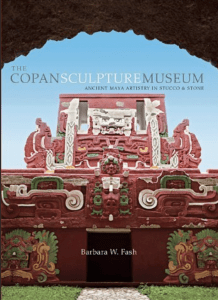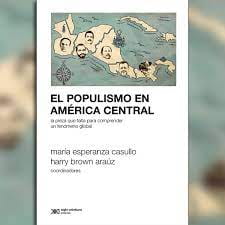A Review of The Copan Sculpture Museum: Ancient Maya Artistry in Stucco and Stone
The Copan Sculpture Museum: Ancient Maya Artistry in Stucco and Stone, by Barbara W. Fash. (Peabody Museum Press, Harvard University, Harvard University Press, 2011, 216 pages).
Barbara Fash’s recent publication, The Copan Sculpture Museum (Peabody Museum Press, 2011, 216 pages), provides a personal account of ongoing efforts to document, examine, consolidate, study, and exhibit the large corpus of sculptures from the ruins of Copan. This ancient city, set in the lavish subtropical region of western Honduras, was constructed by a society of Maya peoples who were adept builders and who thrived there from AD 426 until their demise in the ninth century. Copan’s inhabitants filled the lush contours of the land both in their dynastic center, known today as the Principal Group, and in diverse settlements that sprawled over the valley in a network of carefully planned buildings and exterior spaces.
The Maya are renowned for their refined visual culture that appeals to the west because of its realistic approach in representing natural forms. This graceful imagery dressed Copan’s architecture and numerous free-standing monuments and was generally made of blocks of sculptured mosaic made of the local volcanic tufa stone coated in a thin layer of plaster. The variety of symbols, hieroglyphic blocks, human forms and supernatural composites regaling these architectural structures presented important narratives that scholars have used to understand the Maya worldview.
Copan’s abandonment by the Maya in the ninth century enabled the jungle to reclaim the site with the surrounding luxuriant subtropical forest, while sections that brushed against the banks of the Copan River actually disappeared. Natural disasters also caused buildings to collapse, toppling façades and burying sculptures; this gave Copan’s ruined condition a quixotic ambiance that brought many to visit and study its exquisite corpse. Early explorers and archaeologists drawn to Copan documented what they saw in writing, illustrations, and photographs. Some, unable to resist its allure, carted sculptural keepsakes home, leaving gaps for scholars to reconstruct. Curiously, outside the reconstruction of the famed hieroglyphic stairway, few other major consolidation and restoration efforts took place before William and Barbara Fash created the Copan Mosaics Project in 1985 to analyze and conserve the numerous façade sculptures that remain.
Barbara Fash first came to Copan in 1977, when William Fash invited her to illustrate the monuments uncovered during extended excavations at the site. Except for a couple of short interludes, she has never left. Her artistic and academic efforts have complemented much of William Fash’s distinguished career at Copan (he is Harvard’s Bowditch Professor of Central American and Mexican Archaeology and Ethnology). Over the years their combined efforts have centered on reconstructing Copan’s many three-dimensional conundrums, but in this publication, Barbara Fash, now Director of the Corpus of Maya Hieroglyphic Inscriptions at the Peabody Museum of Archaeology and Ethnology, Harvard University, takes the lead in presenting the impressive sculpture rebuilt by the Copan Mosaics Project on view at the museum. Her contributions to Copan studies and the museum are considerable in every reassembled façade. She is a puzzle-master who has performed an intricate analysis of the collapsed piles of stone—plotting all the fragments to document, separate, and, when possible, reconstruct this lost material culture. Her years of experience and intimate familiarity with Copan’s sculptural corpus have enabled her to rematch fragmented sculpture (through the use of casts)—removed some time ago and now in foreign museum collections—with recently reconstructed Copan building façades. Under the Fashs’ supervision, Copan’s ancient artistic program is visible once again in exhibitions at the Copan Sculpture Museum, which feature sculpture from eighteen structures and seven complete façades.
Composed of twelve succinct chapters, this tome leads the reader through a tour of the two-story Copan Sculptural Museum. Chapters one and twelve focus on the creation and role of the museum as an educational tool that has helped reacquaint the local community with its fragmented past; Chapter two presents the history of archaeological explorations at Copan, while the remaining nine chapters (three through eleven) center on the fifty-eight exhibits in the Copan Sculpture Museum which showcase many reconstructed sculptures and façades, some on exhibit for the first time.
Each chapter includes self-contained sections that sometimes read like museum labels. This stylistic decision, combined with the author’s comment on forty-seven museum exhibits on display, help achieve one of the book’s clear aims as an essential companion to Copan’s Museum. The author’s economic prose covers topics popular to Maya studies as well as new scholarship. She correctly allows the range of sculpted imagery to dictate the direction of her text, discussing familiar topics such as ancestor worship, underworld symbolism, the ball game, ritual sacrifice, warfare, and cosmology. More nuanced concepts are also discussed allowing her to explore the varied artistic programs and socio-political interests of communities outside of Copan’s center.
Abundant historical, archaeological, and exhibition photographs handsomely illustrate this book and are essential to the text. Though there are surprisingly few of the author’s own illustrations, and no plans of the acropolis or of the individual residential zones, the architectural drawings and illustrations complement the photographs, clarifying content and highlighting compositional details. Nearly all of the chapters include the author’s pithy, sidebar sections that highlight specific exhibits, monuments, or concepts. The author mentions key researchers and some specific works in lieu of internal citations and footnotes, while the book’s concise bibliography cites the most salient sources related to the subject at hand. The book provides a requisite starting point for anyone interested in gaining familiarity with Copan’s vast imagery and an essential foundation for any further, serious academic study on the topic.
The Copan Sculpture Museum showcases the extraordinary reconstruction of the colorful Rosalila structure discovered by archaeologists in 1989 that contains an impressive array of supernatural motifs including several green-feathered avian deities Karl Taube has identified as references to K’inich Yax K’uk Mo, Copan’s original dynast. These avian solar deities, Barbara Fash tells us, honor the apotheosized rise of this ruler. The real Rosalila is inaccessible and remains hidden within the bowels of one of Copan’s most important temples, 10L-16 1st. The dramatic piercing of the museum’s open roof by Rosalila’s reconstructed temple celebrates its facsimile presentation to all within the museum and symbolically underscores its visually important vertical axis. Choosing Rosalila as the physical center of this museum resonates with the story of the fifteen subsequent kings at Copan and one of many theses presented in this book: the iconographic themes on structures made visible references to the founding dynast. However, neither the book nor the museum focuses solely on a single theme. For years, Maya studies concentrated on the ruling elite who arguably commissioned the bulk of palace constructions and their accompanying Maya imagery, but Copan has always been an exception to this rule.
From the early investigations by Sylvanus Morley in the 1900s to those later pursued by Gordon Willey and several of his graduate students (including Richard Leventhal and William Fash), activities outside Copan’s “site core” have always garnered attention. Accordingly, both the museum and this book capitalize on this tradition by presenting much imagery from outside the core. In fact, the Museum houses only three of the many famed stelae found at Copan, and fittingly the author devoted only one chapter to discussing these examples and their hypnotically ornate imagery.
The useful color site plan provided in the monograph’s front endpaper locates the many late settled areas outside the dynastic center where sculptural façades have been found. The variety of themes and the wide distribution of sculpture especially on later structures have informed much of Fash’s insightful suggestions. For instance, the recurrent motifs and the sculptural messages consistently presented on the molding of many structures led her to argue, as some have for other Mesoamerican cultures, that architectural décor emulated headbands worn by governing elites. The presence of motifs in structures outside the dynastic center, the author points out, are also visible on structures found in Copan’s Acropolis, specially the “Council House” or popolna. Therefore she suggests that this imagery may have identified a councilor’s or group representative’s abode. A number of specific water motifs on the architectural molding of outlying structures enabled Fash to propose that these may have been the residences of important local water resource administrators.
As critical as the decision to make Rosalila the centerpiece of the Copan Sculpture Museum (and its vibrant image the cover for this book) was the determination to give due importance to the impressively executed sculpture from outside the core. The wide creation of structures with complicated iconography and deftly executed imagery in the periphery, Fash contends, brought distinction to these places, ultimately empowering them. The presentation and examination of sculpture from areas outside the dynastic center reflect her many studies that explore, among many other topics, a wider distribution of power at Copan. Ironically, it may well be that the very distribution of power that Fash emphasizes in this work most likely contributed to Copan’s twilight, leaving us today with ruins to decipher.
Marcia Mandepora is the rector of the UNIBOL-Guarani “Apiaguaiki Tüpa” in Machareti, Bolivia. She received a Licenciatura in Sociology from the University of San Simón in Cochabamba in 1997, and a Master’s in Bilingual Intercultural Education from PROEIB-Andes and that university in 2000. As one of the first and few Guarani to attain postgraduate education, Mandepora is a leading intellectual and women’s leader of the Assembly of Guarani People and a nationally recognized figure in indigenous education.
Related Articles
A Review of Alberto Edwards: Profeta de la dictadura en Chile by Rafael Sagredo Baeza
Chile is often cited as a country of strong democratic traditions and institutions. They can be broken, however, as shown by the notorious civil-military dictatorship of Augusto Pinochet (1973-1990). And yet, even a cursory view of the nation’s history shows persistent authoritarian tendencies.
A Review of Born in Blood and Fire
The fourth edition of Born in Blood and Fire is a concise yet comprehensive account of the intriguing history of Latin America and will be followed this year by a fifth edition.
A Review of El populismo en América Latina. La pieza que falta para comprender un fenómeno global
In 1946, during a campaign event in Argentina, then-candidate for president Juan Domingo Perón formulated a slogan, “Braden or Perón,” with which he could effectively discredit his opponents and position himself as a defender of national dignity against a foreign power.





